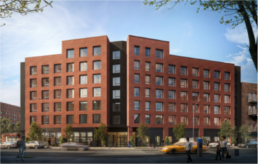Kelly Correia

Kelly Correia
Bookkeeper
Year Joined: 2024
Education and Certifications:
- Bachelor of Business Administration in Accounting, Iona University
Professional Background: Kelly is a former CPA and most recently ran a small business for 7 years, which she successfully sold in 2023.
Position: In her role as Bookkeeper, Kelly assists the Controller with various financial, accounting and administrative tasks.
Personal Life: Kelly enjoys spending time with her family, especially on the beach in LBI and taking long walks with her mastiff Tilly. Her favorite hobby is physical fitness and in her spare time has been teaching barre classes for the past 17 years.
Kristian Lugja

Kristian Lugja
Job Captain
Arquitectura
Year Joined: 2024
Education and Certifications:
- Bachelor of Architecture, New York City College of Technology
Professional Background: Kristian Lugja is a passionate and innovative architecture professional with extensive experience utilizing a wide range of architectural software tools. Known for his creative problem-solving abilities and a keen eye for detail, he has a clear vision for designing functional and dynamic 3D spaces.
Starting his career as an intern at Bertolini Architecture Works, Kristian gained valuable hands-on experience with site visits and reports. He then advanced his career at Ismael Leyva Architects, where he played an integral role in project development, from the initial schematic design phase through to the final issue for construction.
Throughout his career, Kristian has contributed to a variety of projects located in New York City, Florida, and Albania. These diverse experiences have allowed him to refine his design approach and develop a deep understanding of how to address unique architectural challenges while creating innovative, sustainable spaces.
With a commitment to pushing the boundaries of design, Kristian continues to evolve as an architect, delivering high-quality solutions that are both functional and visually impactful.
Position: Kristian’s role as Job Captain includes production of construction documents and coordinating between consultants involved in a given project and helping with daily needs on other active projects.
Personal Life: Outside of architecture, Kristian enjoys playing soccer in his spare time and values spending quality time with his family & friends.
DonDedrick Walker

DonDedrick Walker
Job Captain
Rehabilitation and Preservation
Year Joined: 2025
Education and Certifications:
- Bachelor’s Degree of Architecture, Florida Agricultural and Mechanical University
- Master of Science, Facilities Management
Professional Background: DonDedrick brings over 17 years of experience to Aufgang, beginning his career by working in the field as a junior in High School in 2007. He has experience in all project phases from Schematic Design through Construction Administration. He has worked on a wide variety of buildings, such as single family, multi-family, and luxury residential, as well as K-12 schools, higher education, hospitals, municipal and commercial.
Position: At Aufgang, his projects involve rehabilitation and preservation construction documentation for sets of existing residential buildings in the New York area.
Personal Life: Outside of work, Don enjoys fishing, recreational sports, cooking, reading and freelance design.
Anahy Macias

Anahy Macias
Job Captain
Arquitectura
Year Joined: 2025
Education and Certifications:
- Degree in Architecture, Catholic University of Santiago de Guayaquil
Professional Background: Anahy’s passion for architecture began during her adolescence when, through exchanges in Italy and China, she had the opportunity to immerse herself in traditional architecture from different perspectives. She was born and raised in Ecuador and graduated with honors from the Catholic University of Santiago de Guayaquil, where she specialized in sustainable architecture, mainly focusing on materials and their construction.
Anahy was a member of well-known sustainable design studios in Guayaquil, which allowed her to delve into innovative and environmentally friendly practices. This experience inspired her to take the next step in her career and move to New York, with the aim of expanding her knowledge both personally and professionally and continuing to evolve as an architect.
Position: In her position, Anahy designs and composes compelling graphic presentations for projects throughout the New York region. She also prepares zoning studies for potential new projects.
Personal Life: In her personal time, Anahy enjoys painting, designing spaces and interior furniture, reading self-awareness books, and traveling.
Construction Started on Aufgang Designed 100% Affordable Multifamily Community on Ogden Avenue in the Bronx

Construction Started on Aufgang Designed 100% Affordable Multifamily Community on Ogden Avenue in the Bronx
Construction has begun on an Aufgang Architects designed 100% affordable community that includes supportive housing, located at 1415 Ogden Avenue in the Highbridge section of the Bronx. Total capitalization for the development is $66 million.
The 85 unit Ogden Avenue Theater Apartments will include 51 units of supportive housing for formerly homeless and 34 units for Section 8 residents and those earning at or below 60% of Area Median Income.
NCV Capital and Unique People Services co-developed Ogden Theater Apartments through a public-private partnership with the U.S. Department of Housing and Urban Development, the NYC Department of Housing Preservation and Development and the Department of Mental Health and Hygiene. Financing for the project involves Low Income Housing Tax Credits and HPD’s Supportive Housing Loan Program, as well as private equity.
The Aufgang design for the 100% electric Ogden Theater Apartments meets Passive Housing and Enterprise Green Community Standards. It has a roof-top solar array, variable refrigerant flow HVAC, controlled by residents and a heat pump providing domestic hot water. Other amenities include two elevators, an indoor recreation room, outdoor recreation space, laundry room, bicycle parking and a closed-circuit TV/intercom security system.
“Our design portfolio includes an array of innovative affordable multifamily communities throughout the five boroughs,” said Ariel Aufgang, AIA, Principal of Aufgang Architects. “Ogden Theater Apartments brings much needed affordable and supportive housing to the Bronx.”
“The need for supportive housing is acute throughout New York City, particularly in the Bronx, and with this new affordable development we play a role in finding effective solutions,” said A. Keith Gordon, CEO of NCV Capital Partners.
“We are proud to lead the way with this development of high quality, affordable, sustainable housing in a low-income community. It will improve health outcomes for both our residents and the broader Bronx community” said Yvette B. Andre, Executive Director of Unique People Services.
In the past 22 years Aufgang Architects has designed more than 14,000 units of affordable housing and 20 million square feet of built space. Aufgang Architects is a certified Minority Business Enterprise.
NCV Capital Partners is a Harlem based real estate development and advisory firm engaged in the acquisition, financing, development and management of commercial real estate.
Unique People Services is a nonprofit Bronx based developer of affordable and supportive housing. It has over 32 years of serving special needs populations throughout NYC.
100% Affordable Project Launches in Bronx’s Highbridge Neighborhood

100% Affordable Project Launches in Bronx’s Highbridge Neighborhood
Construction has begun on an Aufgang Architects-designed 100% affordable community that includes supportive housing in the Highbridge section of the Bronx. The 85-unit Ogden Theater Apartments, located at 1415 Ogden Ave., will include 51 units of supportive housing for formerly homeless and 34 units for Section 8 residents and those earning at or below 60% of Area Median Income. Total capitalization is $66 million.
An existing building on the site was demolished. Formerly a movie theater, it was later used as a bowling alley and a church.
NCV Capital and Unique People Services are co-developing Ogden Theater Apartments through a public-private partnership with the U.S. Department of Housing and Urban Development, the NYC Department of Housing Preservation and Development and the Department of Mental Health and Hygiene. Financing for the project involves Low-Income Housing Tax Credits and HPD’s Supportive Housing Loan Program, as well as private equity.
100% Affordable Project Launches in Bronx’s Highbridge Neighborhood

100% Affordable Project Launches in Bronx’s Highbridge Neighborhood
By Steve Griffin
Construction has officially begun on a new affordable community in the Highbridge section of the Bronx, designed by Aufgang Architects. The Ogden Theater Apartments, located at 1415 Ogden Ave., will consist of 85 units and include both supportive housing for formerly homeless individuals and Section 8 units for those earning at or below 60% of Area Median Income. The project is estimated to cost $66 million.
The site was previously occupied by an old building that served as a movie theater before being repurposed as a bowling alley and then later used as a church.
NCV Capital and Unique People Services are partnering together to develop the Ogden Theater Apartments through collaboration with various government agencies such as the U.S. Department of Housing and Urban Development, NYC Department of Housing Preservation and Development, and Department of Mental Health & Hygiene. Funding for this project includes Low-Income Housing Tax Credits, HPD’s Supportive Housing Loan Program, along with private equity investments.
This exciting development marks another step towards providing much-needed affordable housing options in New York City’s ever-growing real estate market.
Construction Started on Aufgang Designed 100% Affordable Multifamily Community in the Bronx

Construction Started on Aufgang Designed 100% Affordable Multifamily Community in the Bronx
Construction has begun on an Aufgang Architects designed 100% affordable community that includes supportive housing, in the Highbridge section of the Bronx.
The 85 unit Ogden Theater Apartments, located at 1415 Ogden Avenue, will include 51 units of supportive housing for formerly homeless and 34 units for Section 8 residents and those earning at or below 60% of Area Median Income.
Total capitalization for the development is $66 million.
An existing building on the site was demolished. It had been a movie theater and was later used as a bowling alley and a church.
NCV Capital and Unique People Services co-developed Ogden Theater Apartments through a public-private partnership with the U.S. Department of Housing and Urban Development, the NYC Department of Housing Preservation and Development and the Department of Mental Health and Hygiene. Financing for the project involves Low Income Housing Tax Credits and HPD’s Supportive Housing Loan Program, as well as private equity.
The community features almost 2,000 square feet of ground‐floor space for social services for residents of the supportive housing units.
The Aufgang design for the 100% electric Ogden Theater Apartments meets Passive Housing and Enterprise Green Community Standards. It has a roof-top solar array, variable refrigerant flow HVAC, controlled by residents and a heat pump providing domestic hot water. Other amenities include two elevators, an indoor recreation room, outdoor recreation space, laundry room, bicycle parking and a closed-circuit TV/intercom security system.
“Our design portfolio includes an array of innovative affordable multifamily communities throughout the five boroughs,” said Ariel Aufgang, AIA, Principal of Aufgang Architects. “Ogden Theater Apartments brings much needed affordable and supportive housing to the Bronx.”
“The need for supportive housing is acute throughout New York City, particularly in the Bronx, and with this new affordable development we play a role in finding effective solutions,” said A. Keith Gordon, CEO of NCV Capital Partners.
“We are proud to lead the way with this development of high quality, affordable, sustainable housing in a low-income community. It will improve health outcomes for both our residents and the broader Bronx community” said Yvette B. Andre, Executive Director of Unique People Services.
In the past 22 years Aufgang Architects has designed more than 14,000 units of affordable housing and 20 million square feet of built space. Aufgang Architects is a certified Minority Business Enterprise.
NCV Capital Partners is a Harlem based real estate development and advisory firm engaged in the acquisition, financing, development and management of commercial real estate.
Unique People Services is a nonprofit Bronx based developer of affordable and supportive housing. It has over 32 years of serving special needs populations throughout NYC.
Op-ed: Kingsbridge Armory redevelopment is an engine for Bronx economic growth

Op-ed: Kingsbridge Armory redevelopment is an engine for Bronx economic growth
By Ariel Aufgang, AIA
The Bronx is home to what is one of the largest adaptive reuse and preservation projects currently in the United States, the renovation and repurposing of the immense Kingsbridge Armory.
Mayor Eric Adams and Governor Kathy Hochul recently announced approval of a redevelopment plan, based on extensive community input. They selected the development and design team led by Maddd Equities and Joy Construction to reprogram and renovate the Armory and build 450 adjacent units of much needed permanently affordable rental housing. My firm, in collaboration with FX Collaborative, serves as executive architect.
Superlatives abound for the Kingsbridge Armory. It’s the largest Armory in the country. Its main drill hall has approximately 180,000 square feet of floor space free of columns, with a ceiling over 115 feet high. Opened in 1917, the Kingsbridge Armory has been closed for nearly three decades. In that time several different concepts were proposed for its use. None proved viable nor could attract financing for development.
That’s changed.
The first phase of the Kingsbridge Armory mixed use redevelopment project features 25,000 square feet of dedicated community space, state of the art event venue space, sports fields for local youth academies, cultural and commercial space and a workforce development educational facility. Prioritization of these new facilities reflects the extensive, thoughtful input in the “Together for Kingsbridge Vision Plan.”
This ambitious project that defines the future of the Kingsbridge Armory will be transformational for the Bronx.
The redevelopment of this historic and long-underutilized site is also aspirational for the borough, and New York City as a whole. It holds the potential for new and unprecedented economic opportunities. It can be an engine for economic development through direct industrial investment in advanced technologies, bringing 21st Century jobs to Bronx residents.
The renovated Kingsbridge Armory site would offer appealing facilities and resources for large US and international companies seeking an R&D, training and manufacturing presence in an accessible location offering a sizeable, enthusiastic workforce.
US government industrial policy now calls for greater domestic self-sufficiency and less reliance on overseas sources for semiconductors used in everything from consumer products to defense systems. As a result, we’re seeing a proliferation of new microprocessor manufacturing sites throughout the country. These include upstate New York locations with inexpensive industrial space and access to ample electrical power. But these thinly populated rural counties don’t have sizeable workforces. Finding qualified staff is a challenge in small towns.
These large companies should bring their jobs to where the workers are, by establishing semiconductor and possibly pharmaceutical manufacturing and other high-tech facilities in the Bronx, where they will find abundant space at the renovated Kingsbridge Armory. The site also offers reliable electrical power that’s required for chip production, as well as extensive public commuter transportation at the door.
Combined with the major community cultural, recreational and educational facilities, the repurposed Kingsbridge Armory has the potential to draw significant clean, high-tech industrial investment to the Bronx, strengthening the economic and social fabric of the community.
Employment opportunities in the Bronx will be expanded to a broader range of well paying, high-tech industry jobs, enabled by new educational and job training facilities at the Armory.
The Bronx is the only New York City borough that’s part of the mainland US, not separated by a river or harbor on an island. That physical connection to America should also be manifest in the participation of the Bronx in the transformation of the national economy and industry creating technologically advanced employment opportunities.
Kingsbridge Armory will generate positive perceptions of the Bronx as a smart and desirable place to establish state of the art high tech R&D and manufacturing sites among US and multinational technology companies.
Ariel Aufgang is principal of Aufgang Architects.
Colonial Gardens renovation plan revised, includes slight reduction in proposed units at Kingston complex

Colonial Gardens renovation plan revised, includes slight reduction
in proposed units at Kingston complex
By BRIAN HUBERT BRIAN HUBERT | Daily Freeman
KINGSTON, N.Y. — The city’s Planning Board viewed revised plans for a proposed four-story building with one-bedroom apartments for seniors at Colonial Gardens calling for a slight reduction in units to with one-bedroom apartments for seniors at Colonial Gardens calling for a slight reduction in units to 80.
The revised plans, submitted by the Kingston Housing Authority and its development partner Mountco at the Monday Planning Board meeting, shave off a portion of the fourth floor closest to Flatbush Avenue and a pair of neighboring homes, leaving a three-story corner on this end of the building. Avenue and a pair of neighboring homes, leaving a three-story corner on this end of the building. Himanshu Tailor, a representative with Aufgang Architects who is working on the project, noted this effort to soften the impact of the building on the neighborhood, known as a “setback,” comes at the expense of two apartments resulting in the reduction of units to 80 from the 82 originally proposed.
The project, developed by the Kingston Housing Authority and Mountco, calls for demolishing two existing buildings in the Penn Court “Annex” site at the public housing complex at 206 Flatbush Ave. The existing buildings that would be demolished have 32 studio apartments. Mountco has said that 98 existing units of one, two and three bedrooms at Colonial Gardens will also be rehabilitated as part of existing units of one, two and three bedrooms at Colonial Gardens will also be rehabilitated as part of the project. the project.
City Planner Sue Cahill also suggested they soften this facade by adding windows. Tailor said they could show renderings with that at January’s meeting.
Mountco’s Executive Vice President of Development and General Counsel John Madeo said the revised plans also lowered the building by 2.5 feet, reducing the perceived height to neighbors. He added that plans also lowered the building by 2.5 feet, reducing the perceived height to neighbors. He added that the developers studied going lower, but they ran into problems with a utility easement.
They also presented renderings with landscaping, including evergreen trees and flowers to help screen the project from those traveling down the hill on Flatbush Avenue towards the building and those who live in neighboring homes.
The presentation also showed a number of landscaped “contemplative spaces” that developers hope to use to activate the space outside the building.
Board members seemed satisfied with the modifications to the building and landscape plan.
“This project is definitely moving in the right direction,” Planning Board Chair Wayne Platte Jr. said.
“The landscaping and stepped-back facade made a huge difference,” Board member Robert Jacobsen “The landscaping and stepped-back facade made a huge difference,” Board member Robert Jacobsen added. Jacobsen had presented numerous concerns about the project’s scale and requests for multiple major waivers at November’s meeting.
Board member Kaira Grundig also praised the landscaping proposed.
The board and Mountco and Kingston Housing Authority representatives also discussed what would happen if the fourth floor was shaved off altogether on the Flatbush Avenue side of the building. Tailor cautioned that this would reduce the number of units to 72.
Kingston Housing Authority Executive Director Harolda Wilcox emphasized that the authority wants to get as many units at the housing complex as possible. “The reduction from 82-72 is significant,” Wilcox said.
The board also questioned what would happen if the building was reduced to three floors.
Wilcox noted this would reduce the number of units to 60.
Wilcox emphasized she knows of many seniors living in their cars who are in desperate need of housing options like this project will offer.
Madeo said that larger reductions in the number of units could make the financial situation tighter too, but he stopped short of saying it would derail the project altogether. but he stopped short of saying it would derail the project altogether.
A reduced number of units would not result in higher rents for tenants, he said.
He also warned the board that the state is prioritizing working with Housing Authorities where He also warned the board that the state is prioritizing working with Housing Authorities where municipal leaders are cooperative with these types of projects. A drawn-out planning process could see other municipalities get in line ahead of Kingston, he added. “This board does not want to hold up this project,” Platte said in response.
Madeo said they expect to have requested traffic study by January’s meeting.

